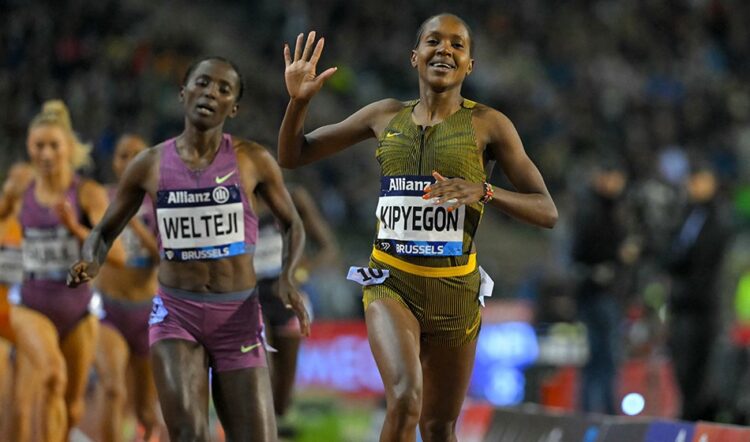Not solely will Religion Kipyegon put the eyes of the world on her sport, as Ben Bloom discovers her sub-four mission may also alter the face of teaching strategies perpetually
How does a rare athlete, who has already run a mile nearly 5 seconds faster than any girl in historical past, presumably put together to knock seven extra off her time?
It’s a herculean endeavor that can have occupied a lot of Religion Kipyegon and her esteemed coach Patrick Sang’s ideas in current weeks since her audacious quest was introduced to change into the primary girl ever to run a mile in beneath 4 minutes.
The Kenyan will benefit from help for her try in Paris, rendering it unratifiable beneath World Athletics guidelines. The exact particulars haven’t been launched, however it can nearly definitely embody the most recent prototype Nike footwear, male pacemakers and maybe some kind of wind-shielding protocol or streamlined equipment.
Regardless, Kipyegon will nonetheless need to propel herself at sooner speeds for an extended time than she has ever managed earlier than.
“If she didn’t consider in herself, I don’t suppose she would have taken on the venture, in order that makes me suppose she’s able to coming actually near it,” says Bram Som, who coached Kipyegon earlier than her change to Sang in 2017, and created the Wavelight pacemaker know-how that shall be employed in Paris.
“She all the time has a extremely good feeling between what her physique wants and what’s on the programme, when to push and when not. When there needs to be one thing performed – like once we have been working in direction of an enormous championship – there was an enormous focus. She might do issues in coaching that I didn’t even know she was able to. She is robust like that – capable of actually push when she must.”
Kipyegon started her 2025 marketing campaign with a slender miss at a 1000m world-record try in Xiamen, ending 0.23 off the two:28.98 time recorded by Russia’s Svetlana Masterkova in 1996. To attain the inconceivable of dipping beneath the four-minute mark for the mile, she should keep that tempo nearly precisely for the remaining 609m in Paris.
Geoff Wightman, who coached his son Jake to world 1500m gold in 2022, believes the primary hurdle to beat is psychological.
“Till someone does it, everybody thinks it’s not possible, out of attain or generations away,” he says. “Roger Bannister’s file solely lasted a matter of weeks earlier than it was damaged.
“Religion ran 1000m for a season opener at precisely the suitable pace. So if you happen to go off that, you say: ‘You solely need to maintain that going for an additional lap and a half, however we’ll put in male pacemakers, the very newest shoe tech – even when it’s in prototype kind – there shall be a stadium full of individuals, and all it’s important to do is glue your self to the runners in entrance. You simply need to maintain going on the pace you’ve performed for two-and-a-half laps.’
“Psychologically, if you happen to begin taking a look at it in these phrases, it’s not that tough. By way of enhancing her world file, it’s a quantum leap. But it surely’s going to be in circumstances which are fairly totally different. She’s at her peak and he or she’s began the season nicely by operating two-and-a-half laps at this pace. It’s a step, however I believe it’s a step she’ll be up for.”
Jenny Meadows, who coaches Olympic 800m champion Keely Hodgkinson and 1500m bronze medalist Georgia Hunter-Bell, suggests Kipyegon’s even pacing throughout that current 1000m efficiency shall be key.
“Throughout that race, you might see she is fairly robotic,” says Meadows. “I checked out each 200m cut up and so they have been actually comparable. That is a perfect means of attempting to run this mile. There ought to be little or no distinction between each lap.
“You need to really feel such as you’re cruising the primary lap, then your coronary heart price goes up a bit bit in your second lap, the third lap would really feel harder and your fourth lap you’re simply combating. Religion is a legend so if anybody can do it, it’s her.”
However – warning that succeeding in breaking 4 minutes is “going to depend on a variety of technological developments” – Meadows provides that it’s vitally essential for Kipyegon to be well-accustomed with the prototype spikes Nike have created for the occasion.
“There’s going to be one thing drastic in no matter footwear she is utilizing,” says Meadows. “I presume she’s had a while in that footwear, as a result of that’s going to really feel fairly unusual.
“Immediately your operating mechanics are going to really feel fairly totally different since you’re asking somebody to run nearer to eight seconds sooner than she ever has earlier than. She might want to get used to that new operating fashion and the way it feels.
“There’s additionally realizing the place try to be across the observe. It’s nearly like your pure judgement and gauge of the place try to be at totally different factors may have modified.”

For Som, that shift in engrained decade-long information is one thing to faucet into and exploit. With Kipyegon needing to run a lot sooner than she ever has earlier than, Som believes she would profit from avoiding her typical coaching periods and switching to non-standardised distances.
“It’s extra of a psychological preparation,” he explains. “Generally you might be caught in patterns that you just do on a regular basis. Repetitions. You do coaching periods the place the consequence earlier than you’ve got even performed it.
“I believe it’s important to get out of sure patterns which lead you in direction of a sure efficiency. Do issues otherwise which are out of your scope. Do new issues the place your thoughts isn’t already capable of recognise it, to know what the result’s.
“Once I was competing, if I did a typical 800m session of 10 x 200m, with every rep in sub-26, it will really feel a sure means and I’d know that I might run a sub-1.45 [for 800m]. I believe it’s important to do away with a few of these standardised periods and transfer in direction of one thing totally different the place you principally prepare the identical however your thoughts doesn’t know what it means for competitors. That’s what I’d do.”

As for the way she will go about making ready herself for the problem of sustaining her quickest tempo far longer, Wightman suggests the secret’s increasing on race simulation periods that she’s going to likely have undertaken all through her profession.
“What she has to attempt to recreate – and I’m certain she does this regularly – is that skill to run the final lap on closely lactic-filled legs, the place the cadence goes, the place the respiratory is maxed out and the lactic ranges are excessive,” he says.
“You recreate that in coaching by doing race simulation. You would possibly do units of 400s in pairs at race tempo. Pause for 15, 30, 45 seconds, after which do one other one once you’re completely filled with lactic, attempting to carry your kind collectively, however attempting to match that pace. Then take an extended restoration and do one other pair like that.
“You’re simulating the kind of lactic gap that you just’ll be in on the bell, however getting used to with the ability to keep kind for that final 60 seconds. She might be the professional at that already. That is simply the marginally subsequent degree.”
No matter what performs out in Paris, and the way shut Kipyegon involves that beforehand unthinkable four-minute barrier, Meadows’ essential space of intrigue is what occurs after. Simply how briskly will Kipyegon go in her subsequent few races – her 1500m world file set in Paris final summer time have to be unsure – and what affect would possibly this problem have on future coaching strategies for all athletes?

“As a coach, you need your athletes to journey at sooner speeds than they’re used to,” explains Meadows. “That’s why folks use heavier coaching units like weighted belts or no matter else, in order that once you take it off you’re feeling actually quick.
“That is the alternative. That is permitting you to really feel sooner than you usually would, which ought to promote a neurological stimulus – you’d suppose the mind will get used to it. So, even when the shoe know-how isn’t allowed in competitions, will or not it’s allowed as a coaching machine to journey at that pace and assist your mind make the connection once you return to the permitted shoe know-how?”
In that case, would possibly one individual’s manufactured time problem change every little thing we find out about athletics teaching?
































